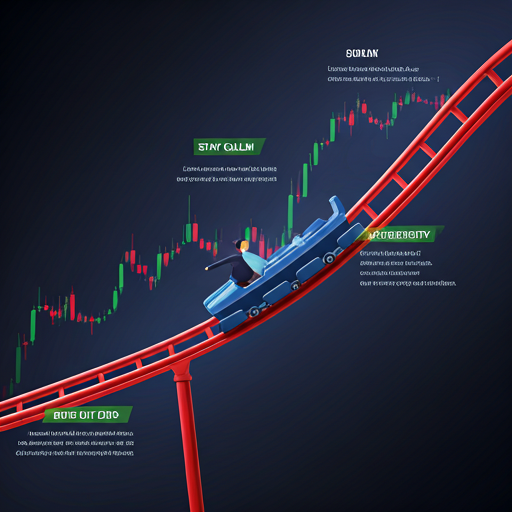Navigating the Stock Market Rollercoaster: Tips for Investors
What Causes Market Fluctuations?
Market fluctuations are primarily driven by a combination of economic indicators, investor sentiment, and geopolitical events. Economic reports, such as employment data and inflation rates, can significantly influence market behavior. When these indicators show positive trends, investor confidence typically rises, leading to increased buying activity. Conversely, negative reports can trigger panic selling.
Investor sentiment plays a crucial role as well. Market psychology often leads to herd behavior, where individuals follow the actions of others rather than making independent decisions. This can amplify price movements, creating volatility. It’s fascinating how emotionx can sway markets.
Geopolitical events, such as elections or international conflicts, also contribute to market instability. Uncertainty surrounding these events can lead to rapid shifts in investor behavior. Awareness is key in such situations. Understanding these factors can help investors navigate the complexities of the stock market.
The Impact of Economic Indicators
Economic indicators significantly influence market trends and investor decisions. Reports on GDP growth, unemployment rates, and inflation provide insights into economic health. Positive indicators often lead to increased investor confidence. This can drive stock prices higher. Conversely, negative data can trigger market sell-offs. It’s crucial to stay informed about these reports. They can create opportunities or risks. Understanding these indicators helps investors make informed choices. Knowledge is power in investing.
Investment Strategies for Uncertain Times
Diversification: Spreading Your Risk
Diversification is a key strategy for managing investment risk. By spreading investments across various asset classes, an investor can reduce the impact of poor performance in any single area. This approach helps to stabilise returns over time. It’s a smart move. Different assets often react differently to market conditions. This can create balance in a portfolio. Investors should consider including stocks, bonds, and alternative investments. A well-rounded portfolio is essential . Understanding this concept is vital for long-term success. Knowledge leads to better decisions.
Long-Term vs. Short-Term Investing
Long-term investing typically involves holding assets for several years to benefit from compounding returns. This strategy allows investors to ride out market volatility. It’s a wise approach. In contrast, short-term investing focuses on quick gains through frequent trading. This method can be riskier due to market fluctuations. Investors must be prepared for rapid changes. Additionally, long-term investors often benefit from lower tax rates on capital gains. Understanding these differences is crucial for effective portfolio management. Knowledge empowers better investment choices.
Technical Analysis: Reading the Market
Key Indicators to Watch
Key indicators in technical analysis include moving averages and relative strength index (RSI). Moving averages help smooth price data to identify trends over time. This can reveal potential entry and exit points. RSI measures the speed and change of price movements, indicating overbought or oversold conditions. Understanding these indicators is essential for making informed trading decisions. They provide valuable insights into market momentum. Knowledge of these tools enhances an investor’s analytical capabilities. Effective analysis leads to better outcomes.
Chart Patterns and Trends
Chart patterns, such as head and shoulders or triangles, provide insights into potential market movements. These formations can indicate reversals or continuations of trends. Recognizing these patterns is crucial for effective trading. They often signal when to enter or exit positions. Understanding trends, whether bullish or bearish, helps investors align their strategies accordingly. Awareness of market sentiment is vital. Knowledge of chart patterns enhances decision-making skills. It’s essential for successful investing.
Emotional Discipline in Trading
Recognizing Emotional Triggers
Recognizing emotional triggers is essential for maintaining discipline in trading. Emotional responses can lead to impulsive decisions that undermine investment strategies. Identifying these triggers allows traders to develop coping mechanisms. This awareness fosters better decision-making. For instance, fear of missing out can prompt hasty trades. Understanding this can prevent costly mistakes. Additionally, managing stress through techniques like mindfulness can enhance focus. A calm mind leads to clearer judgment. Awareness is key in trading success.
Developing a Trading Plan
Developing a trading plan is crucial for consistent success in the markets. A well-structured plan outlines specific goals, risk tolerance, and entry and exit strategies. This clarity helps mitigate emotional decision-making. He should define his trading style, whether day trading or swing trading. Each style requires different approaches and risk management techniques. Additionally, incorporating performance metrics allows for ongoing evaluation and adjustment. Regular reviews enhance strategy effectiveness. A solid plan fosters discipline and reduces impulsive actions. Discipline is vital for long-term profitability.
Utilizing Cryptocurrency as a Hedge
Understanding Crypto’s Roie in Diversification
Understanding cryptocurrency’s role in diversification is essential for modern investors. Cryptocurrencies often exhibit low correlation with traditional assets like stocks and bonds. This characteristic can enhance portfolio resilience during market downturns. He should consider allocating a portion of his investments to digital assets. This can provide a hedge against rising prices and currency devaluation. Additionally, the decentralized nature of cryptocurrencies offers unique advantages. They can serve as a safeguard in times of economic uncertainty. Knowledge of these dynamics is crucial for effective risk management.
Risks and Rewards of Crypto Investments
Investing in cryptocurrencies presents both risks and rewards. Key risks include:
On the other hand, potential rewards consist of:
He should weigh these factors carefully. Understanding these dynamics is essential. Knowledge is crucial for informed decisions.
Staying Informed: Resources for Investors
News Outlets and Market Analysis Tools
Staying informed is crucial for successful investing. Reliable news outlets and market analysis tools provide valuable insights. Key resources include:
He should utilize these resources regularly. They help in understanding market trends. Access to accurate information is vital. Knowledge empowers better investment decisions.
Community and Networking Opportunities
Community and networking opportunities are essential for investors. Engaging with like-minded individuals can provide valuable insights and support. He should consider joining investment clubs or online forums. These platforms facilitate knowledge sharing and collaboration. Additionally, attending industry conferences can enhance professional connections. Networking often leads to new investment ideas. Building relationships is crucial in this field. Knowledge shared within a community is powerful.
